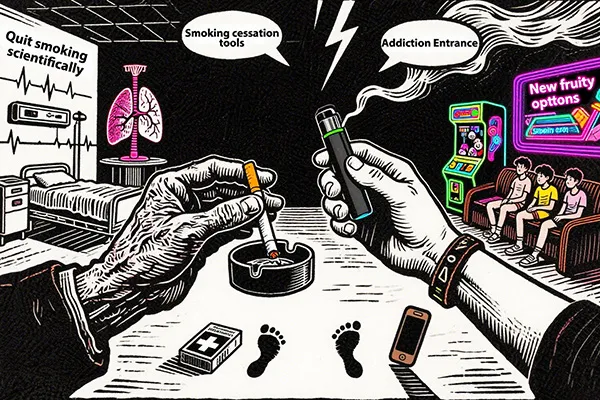You can master the latest information, new product , exhibition, promotion, etc
The global e-cigarette market has expanded rapidly over the past decade, with proponents hailing it as a “safer alternative to traditional cigarettes” and a powerful quit-smoking aid, while critics warn it is a “gateway to nicotine addiction” for teenagers and carries hidden health risks. This debate has divided public health experts, policymakers, and consumers worldwide. As governments, scientists, and users grapple with conflicting evidence, one question looms large: Are e-cigarettes a tool to quit smoking—or a new epidemic of addiction?
Part 1: The Case for E-Cigarettes as a Quit-Smoking Tool
Advocates of e-cigarettes, including many public health researchers and smoking cessation specialists, argue that these devices play a vital role in helping smokers break their addiction to traditional cigarettes—one of the leading causes of preventable death globally.
1.1 Lower Harm Compared to Traditional Cigarettes
Unlike conventional cigarettes, which burn tobacco and produce tar, carbon monoxide, and over 7,000 toxic chemicals (including 70+ carcinogens), e-cigarettes heat a nicotine-containing liquid (e-juice) to produce an aerosol. A 2018 report by the UK’s Public Health England (PHE) concluded that e-cigarettes are “at least 95% less harmful than smoking tobacco.” This reduced harm means smokers who switch to e-cigarettes have lower risks of lung cancer, heart disease, and respiratory illnesses.
1.2 FDA-Approved as a Smoking Cessation Device
In 2021, the U.S. Food and Drug Administration (FDA) approved the first e-cigarette product as a “modified risk tobacco product” (MRTP) for adult smokers. The approval was based on evidence that the device helps smokers quit or reduce cigarette use, with a lower exposure to harmful chemicals. Similarly, the European Union’s Tobacco Products Directive (TPD) recognizes e-cigarettes as a harm reduction tool when used by adult smokers.
1.3 Real-World Quit-Smoking Success
Studies support e-cigarettes’ effectiveness in smoking cessation. A 2023 study published in The Lancet Public Health analyzed data from 15,000 smokers in the U.S. and UK and found that smokers who used e-cigarettes daily were 2.5 times more likely to quit smoking completely than those who used nicotine patches or gum. Many former smokers also report that e-cigarettes mimic the “hand-to-mouth” ritual of smoking, making it easier to replace the habit.

Part 2: The Case Against E-Cigarettes—A New Addiction Gateway
Critics, including the World Health Organization (WHO) and pediatric health experts, argue that e-cigarettes are not a “harmless quit aid” but a public health threat—especially for young people—and often lead to new nicotine addictions rather than ending them.
2.1 Youth Vaping Epidemic: Nicotine Addiction Starts Early
The biggest concern is the surge in youth vaping. According to the U.S. Centers for Disease Control and Prevention (CDC), 14.1% of U.S. high school students reported using e-cigarettes in 2022—up from 11.3% in 2021. Nicotine is highly addictive for adolescents, whose brains are still developing (until age 25). The WHO warns that youth who use e-cigarettes are 3 times more likely to later use traditional cigarettes. Flavored e-juices (e.g., mint, fruit, candy) are blamed for attracting teenagers, with 85% of youth vapers citing flavor as a key reason for use.
2.2 Nicotine Addiction Risks Persist
E-cigarettes deliver nicotine, a highly addictive substance that raises blood pressure, impairs brain development in youth, and can lead to dependence. A 2022 study in JAMA Pediatrics found that 50% of adolescent e-cigarette users report “moderate to severe” nicotine addiction, including cravings and withdrawal symptoms (irritability, difficulty concentrating) when not using. For non-smokers—especially teens—e-cigarettes introduce nicotine addiction where none existed before.
2.3 Unknown Long-Term Health Effects
While e-cigarettes are less harmful than traditional cigarettes, their long-term health impacts are still unclear. Research has linked e-cigarette use to lung damage (known as “e-cigarette or vaping product use-associated lung injury”), which killed over 60 people in the U.S. between 2019 and 2020. E-cigarettes also contain chemicals like formaldehyde (a carcinogen) and diacetyl (linked to lung disease). The WHO notes that “no e-cigarette is completely safe” and warns against unregulated products with high nicotine levels.
Part 3: Balancing the Debate—Context Matters
The debate over e-cigarettes often ignores a key factor: context. E-cigarettes’ impact depends on who uses them, how they use them, and the regulatory environment.
For adult smokers who cannot quit with other methods, e-cigarettes may be a life-saving harm reduction tool.
For never-smokers—especially adolescents, e-cigarettes pose a clear addiction risk and should be restricted.
Policymakers are increasingly adopting this nuanced approach. For example:
The UK allows e-cigarette sales to adults but bans sales to minors and restricts flavors.
Canada has banned most flavored e-juices but permits medical e-cigarettes for smoking cessation.
The U.S. has banned fruit and candy flavors in cartridge-based e-cigarettes but allows menthol and tobacco flavors for adults.
Conclusion: It’s Not an Either/Or—But a Call for Smart Regulation
E-cigarettes are neither a “miracle quit tool” nor a “public health disaster”—they are a complex product with both benefits and risks. The key is to regulate them to maximize their potential as a smoking cessation aid for adults while minimizing their appeal to youth.
For consumers, adult smokers should consult healthcare providers before using e-cigarettes to quit, while parents should talk to their children about the risks of nicotine addiction. For policymakers, balancing access for adults and protection for youth is the path forward. Only with evidence-based regulation can we ensure e-cigarettes work for public health—not against it.









